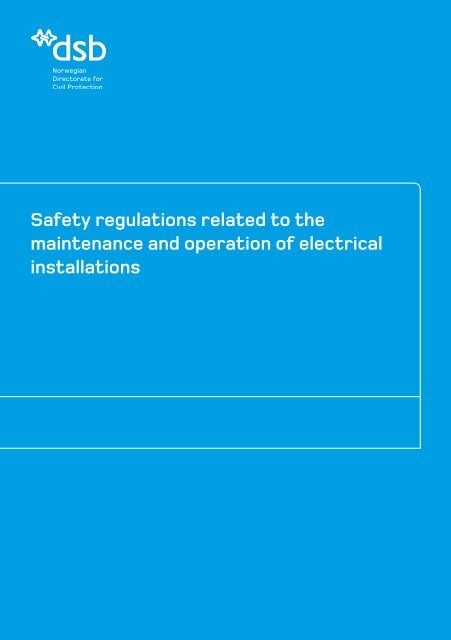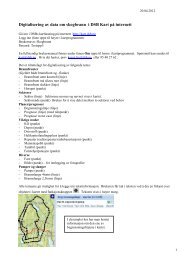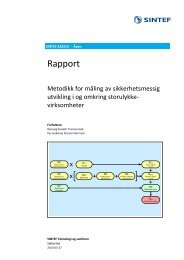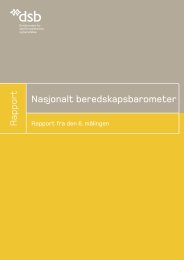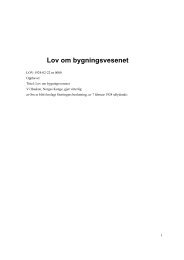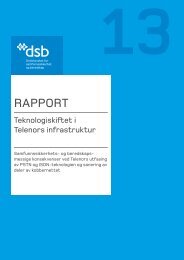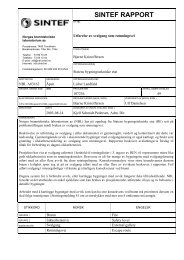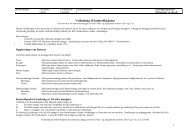Safety regulations related to the maintenance and operation of ...
Safety regulations related to the maintenance and operation of ...
Safety regulations related to the maintenance and operation of ...
- No tags were found...
You also want an ePaper? Increase the reach of your titles
YUMPU automatically turns print PDFs into web optimized ePapers that Google loves.
<strong>Safety</strong> <strong>regulations</strong> <strong>related</strong> <strong>to</strong> <strong>the</strong><strong>maintenance</strong> <strong>and</strong> <strong>operation</strong> <strong>of</strong> electricalinstallations
Published by: Norwegian Direc<strong>to</strong>rate for Civil Protection (DSB) 2013ISBN: 978-82-7768-313-3
PrefaceThe <strong>Safety</strong> <strong>regulations</strong> <strong>related</strong> <strong>to</strong> <strong>the</strong> <strong>maintenance</strong> <strong>and</strong> <strong>operation</strong> <strong>of</strong> electrical installations arelaid down by <strong>the</strong> Direc<strong>to</strong>rate for Civil Protection, 28 April 2006, pursuant <strong>to</strong> <strong>the</strong> Act <strong>of</strong> 24May 1929 No. 4 relating <strong>to</strong> <strong>the</strong> supervision <strong>of</strong> electrical installations <strong>and</strong> equipment § 2, cf.delegation resolution from <strong>the</strong> Ministry <strong>of</strong> Justice <strong>and</strong> Police <strong>of</strong> 1 September 2003 No. 1161.Primary responsibility for fulfilling <strong>the</strong> requirements <strong>of</strong> <strong>the</strong> Regulations rests with <strong>the</strong>owner/manager <strong>of</strong> <strong>the</strong> electrical installation, <strong>and</strong> <strong>the</strong> owner <strong>of</strong> <strong>the</strong> enterprise conductingactivities covered by <strong>the</strong> Regulations. This responsibility may require <strong>the</strong> owner/manager <strong>to</strong>employ persons whose qualifications meet <strong>the</strong> requirements <strong>of</strong> <strong>the</strong> Regulations for electricalenterprises <strong>and</strong> qualifications <strong>to</strong> work on electrical installations <strong>and</strong> electrical equipment,in order <strong>to</strong> be capable <strong>of</strong> operating, maintaining <strong>and</strong> repairing high voltage <strong>and</strong> low voltageinstallations, <strong>and</strong> <strong>to</strong> ensure that satisfac<strong>to</strong>ry routines for work on <strong>the</strong> installation areestablished.These guidelines <strong>to</strong> <strong>the</strong> Regulations provide more detailed information <strong>related</strong> <strong>to</strong> <strong>the</strong>Regulations. The Regulations are framework <strong>regulations</strong> based on <strong>the</strong> principle thatwell-established international st<strong>and</strong>ards form <strong>the</strong> basis <strong>of</strong> <strong>the</strong> safety requirements <strong>of</strong> <strong>the</strong>Regulations. The Direc<strong>to</strong>rate for Civil Protection regard <strong>the</strong> Norwegian electro-technicalst<strong>and</strong>ard NEK EN 50110-1 as satisfying <strong>the</strong> safety requirements in <strong>the</strong>se Regulations. If <strong>the</strong>conditions <strong>of</strong> <strong>the</strong> Regulations, guidelines <strong>and</strong> st<strong>and</strong>ards are met, <strong>the</strong> safety requirements <strong>of</strong><strong>the</strong> Regulations may be considered as being satisfied.Solutions that deviate from those given in <strong>the</strong> guidelines <strong>and</strong> st<strong>and</strong>ards may be acceptable,assuming <strong>the</strong> safety intentions <strong>of</strong> <strong>the</strong> Regulations are maintained. Where <strong>the</strong> term ”must”is used, it should be assumed that <strong>the</strong> solution presented in <strong>the</strong> Regulations is <strong>the</strong> onlysolution that fully meets <strong>the</strong> requirements. Any reasons for choosing any o<strong>the</strong>r solutionmust be documented <strong>and</strong> proven as achieving an equivalent or higher level <strong>of</strong> safety thanthat given in <strong>the</strong> guidelines <strong>and</strong> st<strong>and</strong>ards. In such cases, this must be documented in <strong>the</strong>Internal Control System (regarding HSE) <strong>of</strong> <strong>the</strong> enterprise <strong>and</strong> be available for examinationby <strong>the</strong> inspection authorities. Where <strong>the</strong> term ”should”, ”may” or ”can” is used, <strong>the</strong> proposedsolution should be considered as being one <strong>of</strong> several possible acceptable ways <strong>of</strong> meeting<strong>the</strong> requirements. In such cases, <strong>the</strong> reasons for <strong>the</strong> alternative choice do not need <strong>to</strong> bedocumented.One <strong>of</strong> <strong>the</strong> aims <strong>of</strong> <strong>the</strong> Regulations is <strong>to</strong> work <strong>to</strong>wards common requirements throughout <strong>the</strong>3
EØS region. The aim is that all member countries will implement EN 50110-1in <strong>the</strong>ir national <strong>regulations</strong>. On this basis, <strong>the</strong> Direc<strong>to</strong>rate for Civil Protectionregards <strong>the</strong> methods given in NEK EN 50110-1 <strong>to</strong> be those that best meet <strong>the</strong>safety requirements in <strong>the</strong> Regulations.The use <strong>of</strong> common methods for establishing safety measures will contribute <strong>to</strong>reducing <strong>the</strong> risk <strong>of</strong> unwanted incidents, associated with <strong>the</strong> import <strong>of</strong> servicesacross national boundaries <strong>and</strong> <strong>the</strong> increasing use <strong>of</strong> external subcontrac<strong>to</strong>rs inNorway.Via normative references, NEK EN 50110-1 refers <strong>to</strong> o<strong>the</strong>r relevant st<strong>and</strong>ards<strong>and</strong> publications that may be applicable. These are listed in an informative annex<strong>to</strong> <strong>the</strong> st<strong>and</strong>ard.This translation is for information purposes only. Legal au<strong>the</strong>nticity remains with<strong>the</strong> <strong>of</strong>ficial Norwegian version as published in Norsk Lovtidend.<strong>Safety</strong> <strong>regulations</strong> <strong>related</strong> <strong>to</strong> <strong>the</strong> <strong>maintenance</strong> <strong>and</strong> <strong>operation</strong> <strong>of</strong>electrical installations.Decreed by <strong>the</strong> Direc<strong>to</strong>rate for Civil Protection, 28 April 2006 pursuant <strong>to</strong> Act <strong>of</strong>24 May 1929 No. 4 relating <strong>to</strong> inspection <strong>of</strong> electrical installations <strong>and</strong> electricalequipment § 2, cf. delegation decision 1 September 2003 No. 1161.4
Chapter I – Introduc<strong>to</strong>ryprovisions <strong>and</strong> definitions§ 1. PurposeThe purpose <strong>of</strong> <strong>the</strong> Regulations is <strong>to</strong> maintain a high level <strong>of</strong> safety during <strong>operation</strong> <strong>and</strong>work on or in <strong>the</strong> vicinity <strong>of</strong> electrical installations, by requiring that all activities beadequately planned <strong>and</strong> necessary safety precautions taken in order <strong>to</strong> avoid risk <strong>to</strong> lifeor health or damage <strong>to</strong> materials or property.Re § 1The Regulations apply <strong>to</strong> work on or in <strong>the</strong> vicinity <strong>of</strong> electrical installations thatare ei<strong>the</strong>r energised or designed <strong>to</strong> be energised, <strong>and</strong> <strong>to</strong> <strong>the</strong> <strong>operation</strong> <strong>of</strong> electricalinstallations.The Regulations also apply <strong>to</strong> electrical installations under construction or beingdismantled if <strong>the</strong>re is any possibility <strong>of</strong> becoming energised, even if this is not intended.The Regulations do not apply <strong>to</strong>:a. Electrical installations on facilities engaged in <strong>the</strong> exploitation <strong>of</strong> petroleum depositsin Norwegian inl<strong>and</strong> waters, Norwegian sea terri<strong>to</strong>ry <strong>and</strong> <strong>the</strong> Norwegian part <strong>of</strong> <strong>the</strong>continental shelf.b. Certain integrated petroleum installations <strong>and</strong> associated onshore pipeline systems.c. Electrical installations on aircraft.d. Electronic communications <strong>and</strong> information systems that are not established <strong>and</strong> usedsolely for <strong>the</strong> <strong>operation</strong> <strong>of</strong> electrical distribution systems.e. Electrical installations in which <strong>the</strong> power is so low that <strong>the</strong>re is no possibility <strong>of</strong>causing injury.f. Operation <strong>of</strong> installations or equipment that meet relevant installation <strong>and</strong> equipmentst<strong>and</strong>ards <strong>and</strong> are designed for use by ordinary persons.§ 2. ScopeThe Regulations also apply <strong>to</strong> practical electrical training <strong>and</strong> teaching, <strong>and</strong> also <strong>to</strong>labora<strong>to</strong>ry-based research <strong>and</strong> development.5
Since electrical installations are designed <strong>to</strong> carry electricity, <strong>the</strong>y may become live ifa switch, fuse, live-working clamp or a link/blade is operated. Live working clampsare designed for making connections in live high voltage overhead lines by means <strong>of</strong>insulated <strong>to</strong>ols.An installation may inadvertently become energised during construction or dismantling,caused by:--atmospheric conditions,--flashover or contact with ano<strong>the</strong>r installation, or--induction from ano<strong>the</strong>r installation.The inspection <strong>of</strong> electrical installations mentioned in a) is <strong>the</strong> responsibility <strong>of</strong> <strong>the</strong>Petroleum <strong>Safety</strong> Authority. The Petroleum <strong>Safety</strong> Authority’s duties also includeinspection <strong>of</strong> safety, emergency planning <strong>and</strong> <strong>the</strong> work environment at certain integratedpetroleum installations <strong>and</strong> associated onshore pipeline systems cf. b). These areinstallations for transferring petroleum products <strong>to</strong> l<strong>and</strong> for processing. This does notapply <strong>to</strong> downstream installations, i.e. installations for distributing petroleum products<strong>to</strong> suppliers <strong>and</strong> end users. The Petroleum <strong>Safety</strong> Authority can provide specificinformation regarding which installations this applies <strong>to</strong> at any time.The Civil Aviation Authority is responsible for inspection <strong>of</strong> electric installations onaircraft, mentioned in c).The Norwegian Post <strong>and</strong> Telecommunications Authority is responsible for inspectingelectronic telecommunications <strong>and</strong> information systems, mentioned in d).Power that is <strong>to</strong>o low <strong>to</strong> be capable <strong>of</strong> causing injury, mentioned in e), means that directcontact would not result in dangerous currents (usually less than 30 mA), <strong>and</strong> thatdangerous flashover would not occur in <strong>the</strong> event <strong>of</strong> a short circuit. The limit values fordangerous currents are given in IEC TR 60 479-1.The definition <strong>of</strong> installation, mentioned in f), includes all types <strong>of</strong> installationswhere electrical pr<strong>of</strong>essionals are not needed for normal <strong>operation</strong>, such as residentialproperties <strong>and</strong> enterprises without electrically qualified employees. An “instructedperson” is a person who has received adequate instruction <strong>to</strong> be able <strong>to</strong> safely conductsimple <strong>operation</strong>al tasks <strong>related</strong> <strong>to</strong> electricity. The term “ordinary person” does notinclude instructed persons. This means that relevant requirements in <strong>the</strong>se <strong>regulations</strong>also apply <strong>to</strong> instructed persons.6
§ 3. Who <strong>the</strong> Regulations are intended forCompany owners <strong>and</strong> owners/managing direc<strong>to</strong>rs <strong>of</strong> installations covered by <strong>the</strong>se<strong>regulations</strong> are responsible for ensuring that activities regulated by <strong>the</strong>se <strong>regulations</strong> areconducted in a acceptable manner.Re § 3 Responsibility – Who <strong>the</strong> <strong>regulations</strong> are intended forPursuant <strong>to</strong> <strong>the</strong> Regulations relating <strong>to</strong> systematic health, environment <strong>and</strong> safetyactivities in enterprises (<strong>the</strong> Internal Control Regulations), a person responsible for anenterprise must ensure that <strong>the</strong> enterprise has an operative internal control system, <strong>and</strong>that <strong>the</strong> employees <strong>and</strong> <strong>the</strong>ir representatives participate in its development. This alsomeans that <strong>the</strong> owner <strong>of</strong> an enterprise must ensure that all who participate in activitiescovered by <strong>the</strong> Regulations do so under conditions that enable <strong>the</strong> activity <strong>to</strong> beconducted safely <strong>and</strong> in accordance with <strong>the</strong> Regulations. This requirement entails <strong>the</strong>provision <strong>of</strong> necessary funds by <strong>the</strong> owner.The Regulations apply <strong>to</strong> all activities where pr<strong>of</strong>essional electrical competence isrequired, as defined in <strong>the</strong> Regulations for electrical enterprises <strong>and</strong> qualifications <strong>to</strong>work on electrical installations <strong>and</strong> electrical equipment.In this context, <strong>the</strong> “owner” <strong>of</strong> <strong>the</strong> enterprise is defined as being <strong>the</strong> owner <strong>of</strong> <strong>the</strong>enterprise that conducts <strong>and</strong> is responsible for <strong>the</strong> <strong>operation</strong> <strong>and</strong> <strong>maintenance</strong> <strong>of</strong> anelectrical installation <strong>and</strong> <strong>the</strong> employment <strong>of</strong> electrical pr<strong>of</strong>essionals. Examples includepower grid companies, electrical contrac<strong>to</strong>rs, industrial enterprises <strong>and</strong> o<strong>the</strong>r enterprisesemploying electrical pr<strong>of</strong>essionals according <strong>to</strong> <strong>the</strong> requirements <strong>of</strong> <strong>the</strong> Regulations forelectrical enterprises <strong>and</strong> qualifications <strong>to</strong> work on electrical installations <strong>and</strong> electricalequipment. The owner <strong>of</strong> <strong>the</strong> enterprise where electrical pr<strong>of</strong>essionals are employed isresponsible for ensuring that employees have received adequate training <strong>and</strong> instruction<strong>and</strong> have <strong>the</strong> necessary competence <strong>and</strong> experience in <strong>the</strong> requirements pursuant <strong>to</strong> <strong>the</strong>Regulations.Where <strong>the</strong> owner <strong>of</strong> an enterprise, cf. <strong>the</strong> above, is also owner <strong>of</strong> <strong>the</strong> electricalinstallation, this person has complete responsibility for ensuring that <strong>the</strong> requirements <strong>of</strong><strong>the</strong>se <strong>regulations</strong> are met.If <strong>the</strong> owner <strong>of</strong> <strong>the</strong> installation has delegated its <strong>operation</strong> <strong>and</strong> management <strong>to</strong> ano<strong>the</strong>renterprise, <strong>the</strong> enterprise running <strong>the</strong> installation is responsible for ensuring that <strong>the</strong>regulation requirements are met. However, <strong>the</strong> owner <strong>of</strong> <strong>the</strong> enterprise is responsiblefor ensuring that <strong>the</strong> operating <strong>and</strong> managing enterprise receives sufficient economic7
provision <strong>to</strong> be able <strong>to</strong> fulfil this responsibility.For both high voltage <strong>and</strong> low voltage installations, <strong>the</strong> Operations Manager is a functionthat is associated with a specific installation. The owner/manager <strong>of</strong> <strong>the</strong> installationis responsible for employing/nominating a suitable person <strong>to</strong> fill this function. TheOperations Manager receives <strong>the</strong> authority <strong>and</strong> responsibility <strong>to</strong> ensure that <strong>the</strong> installationis constructed, operated <strong>and</strong> maintained according <strong>to</strong> <strong>the</strong> requirements <strong>of</strong> <strong>the</strong> Regulations.However, this does not release <strong>the</strong> owner/manager from overall responsibility.If services are purchased from an external enterprise, <strong>the</strong> owner maintains responsibility<strong>and</strong> is not permitted <strong>to</strong> delegate responsibility. The owner/manager <strong>of</strong> <strong>the</strong> installation isresponsible for ensuring that <strong>the</strong> internal control system is coordinated with that <strong>of</strong> <strong>the</strong>external enterprise as far as this is necessary, cf. Internal Control Regulations on HSE.The owner/manager <strong>of</strong> an electrical installation will always maintain overallresponsibility for ensuring that <strong>the</strong> safety requirements in <strong>the</strong> Regulations are satisfiedregardless <strong>of</strong> whe<strong>the</strong>r <strong>the</strong> work is conducted by internal employees or by anexternalsupplier <strong>of</strong> services. An external supplier <strong>of</strong> services will, however, also holdindependent responsibility for ensuring that <strong>the</strong> requirements <strong>of</strong> <strong>the</strong> Regulations are met,also with respect <strong>to</strong> <strong>the</strong> guidelines issued by <strong>the</strong> owner/manager through <strong>the</strong> OperationsManager <strong>of</strong> <strong>the</strong> enterprise purchasing <strong>the</strong> services.If <strong>the</strong> nature <strong>of</strong> <strong>the</strong> work is such that it is covered by <strong>the</strong> Regulations for electricalenterprises <strong>and</strong> qualifications <strong>to</strong> work on electrical installations <strong>and</strong> electrical equipment,only external suppliers <strong>of</strong> services may be used that are registered in <strong>the</strong> Direc<strong>to</strong>rate forCivil Protection’s central register <strong>of</strong> enterprises that plan, conduct <strong>and</strong> maintain electricalinstallations, cf. Regulations for electrical enterprises <strong>and</strong> qualifications <strong>to</strong> work onelectrical installations <strong>and</strong> electrical equipment. The enterprise’s competent electricalmanager will normally be delegated <strong>the</strong> authority <strong>to</strong> oversee <strong>the</strong> responsibilities <strong>of</strong> <strong>the</strong>external enterprise. A competent electrical manager must satisfy <strong>the</strong> requirements <strong>of</strong> <strong>the</strong>Regulations for electrical enterprises <strong>and</strong> qualifications <strong>to</strong> work on electrical installations<strong>and</strong> electrical equipment <strong>and</strong> must manage <strong>the</strong> work in person.In certain cases, <strong>the</strong> owner/<strong>operation</strong>al manager <strong>of</strong> a high voltage installation maydelegate certain areas <strong>of</strong> authority <strong>to</strong> <strong>the</strong> owner <strong>of</strong> an external enterprise, such as <strong>the</strong>authority <strong>to</strong> nominate a <strong>Safety</strong> Supervisor from <strong>the</strong> external enterprise’s own employees.However, such delegation <strong>of</strong> authority does not release <strong>the</strong> owner/<strong>operation</strong>al managerfrom overall responsibility.8
The owner <strong>of</strong> an installation or equipment that satisfies relevant installation <strong>and</strong>equipment st<strong>and</strong>ards, <strong>and</strong> which is designed for use by ordinary persons, is responsiblefor ensuring that <strong>the</strong>se are constructed <strong>and</strong> maintained only by enterprises that areregistered in <strong>the</strong> Direc<strong>to</strong>rate for Civil Protection’s central Regulations for electricalenterprises <strong>and</strong> qualifications <strong>to</strong> work on electrical installations <strong>and</strong> electrical equipment.Beyond this, responsibility is limited <strong>to</strong> fulfilling requirements presented by <strong>the</strong>enterprise conducting <strong>the</strong> work, <strong>and</strong> providing <strong>the</strong> necessary conditions <strong>to</strong> enable <strong>the</strong>enterprise <strong>to</strong> meet <strong>the</strong> safety requirements <strong>of</strong> <strong>the</strong> Regulations.Enterprises employing only instructed persons for conducting simple <strong>operation</strong>altasks are not covered by <strong>the</strong> Regulations. However, <strong>the</strong> owner <strong>of</strong> such an enterprise isresponsible for ensuring that instructions are developed by suitably qualified electricalpr<strong>of</strong>essionals <strong>and</strong> that <strong>the</strong> instructed person receives adequate training <strong>to</strong> maintain <strong>the</strong>irown personal safety. Instruction must be based on <strong>the</strong> requirements <strong>of</strong> <strong>the</strong> Regulations.Although <strong>the</strong> owner/manager <strong>of</strong> an enterprise has primary responsibility, <strong>the</strong> employeesalso have certain duties <strong>and</strong> <strong>the</strong>refore also responsibilities. Refer <strong>to</strong> <strong>the</strong> WorkingEnvironment Act for fur<strong>the</strong>r information.§ 4. DispensationThe authorities may grant dispensation from <strong>the</strong>se <strong>regulations</strong> if special conditions deemthis necessary.Re § 4 DispensationThe Direc<strong>to</strong>rate for Civil Protection considers <strong>the</strong> safety requirements given in <strong>the</strong>Regulations <strong>to</strong> be so fundamental that dispensation is only granted in extremely unusualcircumstances.§ 5. DefinitionsTemporary earthing for workFully-dimensioned earthing <strong>and</strong> short circuiting <strong>of</strong> installation parts where work is beingconducted.Protective shielding or shroudingPart providing protection from direct contact from any usual approach or access point.9
Boundary barrierDemarcation <strong>of</strong> <strong>the</strong> minimum safe distance or o<strong>the</strong>r boundaries which must be respected.Terminal earthingFully-dimensioned earthing <strong>and</strong> short-circuiting <strong>of</strong> all isolation points from which aninstallation may be energised.De-energisingA safety function for de-energising all or a discrete section <strong>of</strong> an electrical installation bydisconnecting <strong>the</strong> electrical installation or section from every source <strong>of</strong> electrical energy.High voltageVoltage which is normally in excess <strong>of</strong> 1000 V a.c. or 1500 V d.c.Low voltageVoltage which normally does not exceed 1000 V a.c. or 1500 V d.c.Switching SupervisorNominated person in control <strong>of</strong> switching <strong>operation</strong>s who is responsible for ensuringthat switching <strong>of</strong> high voltage installations is conducted in a safe manner.<strong>Safety</strong> Supervisor (high voltage)/ <strong>Safety</strong> Supervisor (low voltage)Nominated person in control <strong>of</strong> <strong>the</strong> work activity who is responsible for safety at <strong>the</strong>work site.For work on or in <strong>the</strong> vicinity <strong>of</strong> a railway installation, <strong>the</strong> term Electrical <strong>Safety</strong>Supervisor is used for this function. When <strong>the</strong> term <strong>Safety</strong> Supervisor is used in <strong>the</strong>se<strong>regulations</strong>, <strong>the</strong> same requirements apply <strong>to</strong> <strong>the</strong> function <strong>of</strong> Electrical <strong>Safety</strong> Supervisorinvolved with work on or in <strong>the</strong> vicinity <strong>of</strong> a railway installation.Less than fully-dimensioned earthingEarthing <strong>and</strong> short-circuiting <strong>of</strong> installation parts with a less than fully-dimensionedearthing device on or in close proximity <strong>to</strong> <strong>the</strong> work location.Outer limit <strong>of</strong> live working zoneMinimum distance in <strong>the</strong> air <strong>to</strong> be maintained between a worker <strong>and</strong> any installation parthaving a different potential, or for single-phase work, <strong>the</strong> minimum distance between <strong>the</strong>worker <strong>and</strong> an installation part in a different phase but having <strong>the</strong> same potential. This10
minimum working distance is defined in order <strong>to</strong> ensure that work on or in <strong>the</strong> vicinity<strong>of</strong> an electrical installation is conducted at a safe distance. It defines <strong>the</strong> outer limit <strong>of</strong><strong>the</strong> live working zone.The outer limit <strong>of</strong> <strong>the</strong> live working zone for difference voltages is given in <strong>the</strong> tablebelow. Distances <strong>of</strong> intermediate values may be determined by linear interpolation.Table 1 Outer limit <strong>of</strong> live working zone for different voltagesNominalsystemvoltage (kV)Outer limit <strong>of</strong>live working zone(mm)Nominal systemvoltage (kV)Outer limit <strong>of</strong>live workingzone (mm)< 1 No contact 70 7503 400 110 10006 400 132 110010 400 150 120015* 400 220 160020 400 275 190030 400 380 250036 400 480 320045 500 700 530060 650* Includes 15 kV – 16 2/3 Hz for railways.Outer limit <strong>of</strong> vicinity zoneClosest permitted working position <strong>to</strong> installation parts <strong>and</strong> surroundings with apotential that is different from that <strong>of</strong> <strong>the</strong> worker, or for single phase work, o<strong>the</strong>r phaseswith <strong>the</strong> same potential.The outer limit <strong>of</strong> <strong>the</strong> vicinity zone shall be determined <strong>and</strong> marked for each work task.11
Re § 5 DefinitionsThe Norwegian <strong>regulations</strong> use two different terms for <strong>Safety</strong> Supervisor depending on<strong>the</strong> level <strong>of</strong> voltage. The English version uses <strong>the</strong> term <strong>Safety</strong> Supervisor for both highvoltage <strong>and</strong> low voltage.Fur<strong>the</strong>r relevant definitions are given in NEK EN 50110-1. Definitions <strong>of</strong> o<strong>the</strong>r termsmay be found in International Electrotechnical Vocabulary (IEC 60050-series).12
Chapter II – General provisions§ 6. OrganisationFor every electrical installation, a high voltage or low voltage Operations Manager(nominated person in control <strong>of</strong> an electrical installation) must be nominated <strong>to</strong> beresponsible for <strong>the</strong> <strong>operation</strong> <strong>and</strong> <strong>maintenance</strong> <strong>of</strong> <strong>the</strong> installation. Administrativemeasures must be taken <strong>to</strong> ensure that <strong>the</strong> distribution <strong>of</strong> responsibility does not comein<strong>to</strong> conflict with work on <strong>the</strong> electrical installation or with its <strong>operation</strong>.A high voltage / low voltage <strong>Safety</strong> Supervisor must be nominated for each work task.In high voltage installations, a Switching Supervisor must also be nominated if anyswitching tasks are required.Re § 6 OrganisationThe owner/manager <strong>of</strong> <strong>the</strong> installation is responsible for nominating an OperationsManager.Specific qualification requirements do not apply <strong>to</strong> <strong>the</strong> Operations Manager <strong>of</strong> a lowvoltage installation. In enterprises employing <strong>the</strong>ir own electrical pr<strong>of</strong>essionals whosatisfy <strong>the</strong> requirements in <strong>the</strong> Regulations for electrical enterprises <strong>and</strong> qualifications<strong>to</strong> work on electrical installations <strong>and</strong> electrical equipment. One <strong>of</strong> <strong>the</strong>se electricalpr<strong>of</strong>essionals must be nominated as Operations Manager.The construction, <strong>operation</strong> <strong>and</strong> <strong>maintenance</strong> <strong>of</strong> an electrical installation that belongs<strong>to</strong> a third party, must be managed by an electrical pr<strong>of</strong>essional who satisfies <strong>the</strong>requirements in <strong>the</strong> Regulations for electrical enterprises <strong>and</strong> qualifications <strong>to</strong> work onelectrical installations <strong>and</strong> electrical equipment.High voltage installationsConcerning <strong>the</strong> <strong>operation</strong> <strong>and</strong> <strong>maintenance</strong> <strong>of</strong> high voltage installations, <strong>the</strong> Regulationsfor electrical enterprises <strong>and</strong> qualifications <strong>to</strong> work on electrical installations <strong>and</strong>electrical equipment stipulate that this function must be supervised by a qualifiedperson (Operations Manager). In this context, <strong>the</strong> term qualified means that this personis sufficiently familiar with <strong>the</strong> high voltage installation that switching work may beconducted in a safe manner. At any one time, one person must supervise <strong>the</strong> daily13
<strong>operation</strong> <strong>of</strong> <strong>the</strong> installation. This means that a substitute must be nominated if <strong>the</strong>Operations Manager is not present. The Operations Manager in installations beyond acertain complexity, function <strong>and</strong> size must be an electrically skilled person in accordancewith requirements in <strong>the</strong> Regulations for electrical enterprises <strong>and</strong> qualifications <strong>to</strong> workon electrical installations <strong>and</strong> electrical equipment.At any one time, it must be clear who has <strong>the</strong> authority <strong>to</strong> nominate <strong>and</strong> who hasbeen nominated <strong>to</strong> lead <strong>the</strong> switching work <strong>and</strong> safety measures for work on or in <strong>the</strong>vicinity <strong>of</strong> a high voltage installation. The functions must be referred <strong>to</strong> as “SwitchingSupervisor” <strong>and</strong> “<strong>Safety</strong> Supervisor”.On <strong>the</strong> basis <strong>of</strong> individual assessment, <strong>the</strong> Operations Manager decides who may beauthorised as Switching Supervisor or <strong>Safety</strong> Supervisor. Authorisation is for a limitedtime period only. This means that <strong>the</strong> Operations Manager must regularly reassess aperson’s suitability for <strong>the</strong>se functions. If <strong>the</strong> Operations Manager decides that a personis no longer suited <strong>to</strong> <strong>the</strong> function <strong>of</strong> Switching Supervisor or <strong>Safety</strong> Supervisor, or thatthis function is no longer necessary, authorisation must be withdrawn.The Switching Supervisor leading <strong>the</strong> switching work in a high voltage installation mustfirst have received necessary training <strong>and</strong> written instructions specifying <strong>the</strong> authority<strong>and</strong> responsibility associated with <strong>the</strong> function, <strong>and</strong> specific details <strong>of</strong> <strong>the</strong> switchingwork <strong>the</strong> Switching Supervisor is authorised <strong>to</strong> Supervise (voltage level, geographicarea, switch type, etc.)The <strong>Safety</strong> Supervisor, responsible for safety at <strong>the</strong> worksite, must have received writteninstructions specifying <strong>the</strong> authority <strong>and</strong> responsibility associated with <strong>the</strong> function, <strong>and</strong>details <strong>of</strong> <strong>the</strong> installations where <strong>the</strong> <strong>Safety</strong> Supervisor is authorised <strong>to</strong> supervise safetywork (voltage level, geographic area, installation type, etc.)It is recommended that it be made clear at <strong>the</strong> worksite who holds <strong>the</strong> function <strong>of</strong> <strong>Safety</strong>Supervisor.Low voltage installationsAt any one time, it must be clear who has <strong>the</strong> authority <strong>to</strong> nominate <strong>and</strong> who has beennominated <strong>to</strong> supervise safety measures for work on or in <strong>the</strong> vicinity <strong>of</strong> a low voltageinstallation if more than one person is involved with <strong>the</strong> work. The function is referred<strong>to</strong> as <strong>Safety</strong> Supervisor. Verbal nomination is permitted.On <strong>the</strong> basis <strong>of</strong> individual assessment, <strong>the</strong> Operations Manager decides who may be14
authorised as low voltage <strong>Safety</strong> Supervisor. Authorisation is for a limited time periodonly. This means that <strong>the</strong> Operations Manager must regularly reassess a person’ssuitability for <strong>the</strong> function. If <strong>the</strong> Operations Manager decides that a person is no longersuited <strong>to</strong> <strong>the</strong> function <strong>of</strong> <strong>Safety</strong> Supervisor, or that this function is no longer necessary,authorisation must be withdrawn.For work on or in <strong>the</strong> vicinity <strong>of</strong> an electrical installation owned by a third party,<strong>the</strong> Operations Manager nominated by <strong>the</strong> owner <strong>of</strong> <strong>the</strong> installation or person he hasauthorised, is responsible for nominating a Switching Supervisor <strong>and</strong> <strong>Safety</strong> Supervisorfor high voltage installations <strong>and</strong> a <strong>Safety</strong> Supervisor for low voltage installations. Byagreement, however, <strong>the</strong> owner <strong>of</strong> an installation may transfer <strong>the</strong> authority <strong>to</strong> nominatea <strong>Safety</strong> Supervisor <strong>to</strong> <strong>the</strong> enterprise conducting <strong>the</strong> work. Responsibility for nominatinga <strong>Safety</strong> Supervisor <strong>the</strong>n rests with <strong>the</strong> competent electrical manager in that enterprise.For work on or in <strong>the</strong> vicinity <strong>of</strong> an electrical low voltage installation owned by a thirdparty, <strong>and</strong> where <strong>the</strong> installation is <strong>of</strong> such a nature that <strong>the</strong> owner/ <strong>operation</strong>al manageris not covered by <strong>the</strong> <strong>regulations</strong>, <strong>and</strong> where <strong>the</strong>re is no Operations Manager, <strong>the</strong>competent electrical manager in <strong>the</strong> enterprise conducting <strong>the</strong> work is responsible fornominating <strong>the</strong> low voltage <strong>Safety</strong> Supervisor.§ 7. General overall planningAll enterprises are required <strong>to</strong> have an operative system for general planning.Workers must have access <strong>to</strong>, <strong>and</strong> be familiar with all relevant provisions in both <strong>the</strong>Regulations <strong>and</strong> accompanying guidelines, <strong>and</strong> receive necessary training, practice <strong>and</strong>instruction in <strong>the</strong>se.Re § 7 General overall planningGeneral planning must at a minimum include <strong>the</strong> following:a) development <strong>of</strong> instructions,b) use <strong>of</strong> qualified personnel,c) necessary authorisation <strong>and</strong> permits,d) organisation <strong>and</strong> planning in connection with <strong>the</strong> purchase, use, s<strong>to</strong>rage, testing <strong>and</strong><strong>maintenance</strong> <strong>of</strong> protective equipment <strong>and</strong> o<strong>the</strong>r safety equipment,e) establishing routines for st<strong>and</strong>ard types <strong>of</strong> work,f) training, practice <strong>and</strong> instruction, <strong>and</strong>g) necessary first-aid preparations.15
The Regulations <strong>related</strong> <strong>to</strong> systematic health, environment <strong>and</strong> safety activities inenterprises (Internal Control Regulations) require <strong>the</strong> owner <strong>of</strong> an enterprise <strong>to</strong> conductsystematic checks concerning health, safety <strong>and</strong> environment. This means that <strong>the</strong> owner<strong>of</strong> an enterprise covered by <strong>the</strong> Regulations is responsible for systematically checkingthat <strong>the</strong> requirements <strong>of</strong> <strong>the</strong> Regulations are met <strong>and</strong> that internal routines are followed.Delegation <strong>of</strong> authority in connection with planning, is an example <strong>of</strong> an area whereclear routines must exist.The requirement that personnel must receive necessary training, practice <strong>and</strong> instructionis considered <strong>to</strong> be fulfilled, if this is provided at least annually, <strong>and</strong> more frequently ifconditions indicate that this is necessary. No more than 12 months may lapse betweentraining provisions.Training must be adapted as necessary <strong>to</strong> fit relevant conditions <strong>and</strong> problems for<strong>the</strong> enterprise concerned <strong>and</strong> <strong>the</strong> individual employee’s function (<strong>Safety</strong> Supervisor,Switching Supervisor, etc.). It must also cover <strong>the</strong> enterprise’s internal instructions,procedures <strong>and</strong> guidelines where such exist. Training may also include instruction <strong>and</strong>practical training in <strong>the</strong> use <strong>of</strong> equipment <strong>to</strong> <strong>the</strong> extent such is relevant.Necessary first-aid preparation entails that all personnel receive annual training in firstaid <strong>and</strong> specific training in first aid for electrical accidents. All who work with overheadlines <strong>and</strong> aerial cables must be trained in emergency rescue <strong>operation</strong>s on poles. Trainingmust be repeated at least every 12 months.For larger enterprises, necessary first-aid preparation may entail <strong>the</strong> establishing <strong>of</strong>a first-aid team ei<strong>the</strong>r as part <strong>of</strong> <strong>the</strong> emergency st<strong>and</strong>by team or <strong>the</strong> fire <strong>and</strong> accidentteam. A prerequisite <strong>to</strong> this work is <strong>the</strong> preparation <strong>of</strong> an organisation plan withassociated instructions. This entails developing an emergency plan both for notifying <strong>the</strong>emergency services (police, fire <strong>and</strong> medical assistance), <strong>and</strong> for notifying <strong>the</strong> st<strong>and</strong>byteam.The requirement that personnel be made aware <strong>of</strong> relevant provisions in <strong>the</strong> Regulationsindicates that certain provisions are not applicable or relevant <strong>to</strong> certain types <strong>of</strong>activities or voltage levels. This means that personnel are not required <strong>to</strong> be familiarwith requirements that are not relevant <strong>to</strong> <strong>the</strong>ir own work.When purchasing services from an external enterprise, <strong>the</strong> owner <strong>of</strong> <strong>the</strong> enterprise mustprovide suitable conditions <strong>to</strong> ensure that those conducting <strong>the</strong> work receive necessary16
training, practice <strong>and</strong> instruction <strong>to</strong> enable <strong>the</strong>m <strong>to</strong> conduct <strong>the</strong> task at <strong>the</strong> installation inquestion.Training must be documented in <strong>the</strong> enterprise’s Internal Control System (HSE).General overall planning should also encompass relevant requirements in o<strong>the</strong>r<strong>regulations</strong>, including assessing employees’ exposure <strong>to</strong> electric <strong>and</strong> magnetic fields.This subject area is <strong>the</strong> responsibility <strong>of</strong> <strong>the</strong> Norwegian Radiation Protection Authority(NRPA).§ 8. Accident notificationAll accidents <strong>and</strong> injuries or damage <strong>to</strong> <strong>the</strong> installation or property caused by electricityor arising from work on or <strong>the</strong> <strong>operation</strong> <strong>of</strong> an electrical installation, must be reported at<strong>the</strong> earliest opportunitty <strong>to</strong> <strong>the</strong> applicable authorities.Re § 8 Reporting accidents <strong>and</strong> incidentsThe intention <strong>of</strong> <strong>the</strong> requirement that all accidents <strong>and</strong> incidents be reported is in order<strong>to</strong> discover causes <strong>and</strong> thus help <strong>to</strong> prevent future similar incidents <strong>and</strong> accidents. It isessential that reporting occurs quickly, for example by telephone, telefax or email sothat necessary steps may be taken <strong>to</strong> ensure that information that could contribute <strong>to</strong>discovering <strong>the</strong> cause <strong>of</strong> <strong>the</strong> incident is not removed or destroyed.Serious accidents must be reported immediately by telephone <strong>to</strong> <strong>the</strong> regional branch <strong>of</strong><strong>the</strong> Direc<strong>to</strong>rate for Civil Protection in <strong>the</strong> region in which <strong>the</strong> accident occurred.An electronic report system is available on <strong>the</strong> Direc<strong>to</strong>rate for Civil Protection’swebpage, http://www.dsb.no/stromskader. This should be used for reporting accidentsinvolving injuries.Accidents must also be reported <strong>to</strong> o<strong>the</strong>r authorities.§ 9. AccessTo prevent unauthorised access <strong>to</strong> rooms or enclosed spaces containing unprotectedelectrical installations, all such areas must be kept adequately locked.Routines must be developed <strong>to</strong> govern who is permitted <strong>to</strong> access electrical installations17
that are not protected from contact. For high voltage installations, records must be kep<strong>to</strong>f all persons who have access permission.To prevent inadvertent energising or de-energising <strong>of</strong> high voltage installations, allswitches/operating equipment must be adequately locked.Re § 9 AccessThe requirement that unauthorised persons are not permitted <strong>to</strong> have access <strong>to</strong> rooms orenclosures containing electrical installations which are not protected from direct contact,entails that keys <strong>to</strong> such rooms <strong>and</strong> areas may only be available <strong>to</strong> access-permit holders.Holders <strong>of</strong> access permits must be aware <strong>of</strong> <strong>the</strong> dangers represented by <strong>the</strong> installation.Documentation <strong>of</strong> all access-permit holders must be included in <strong>the</strong> Internal ControlSystem.High voltage installationsDocumentation <strong>of</strong> those with access authorisation should take <strong>the</strong> form <strong>of</strong> checklists <strong>and</strong><strong>the</strong> issuing <strong>of</strong> access permits <strong>to</strong> those who have authorisation <strong>to</strong> access a high voltageinstallation.Persons without access permission may be granted access by someone who is authorised<strong>to</strong> do so. The person must be accompanied by someone who has both access permission<strong>and</strong> <strong>the</strong> authority <strong>to</strong> escort.This provision also applies <strong>to</strong> persons who, pursuant <strong>to</strong> ano<strong>the</strong>r Act or Regulation, arepermitted <strong>to</strong> access an electric installation <strong>to</strong> conduct authorised activity (representativesfrom <strong>the</strong> Labour Inspection Authority, electrically skilled persons, representatives froma board <strong>of</strong> enquiry, or similar bodies. This means that such persons must be grantedaccess, but since <strong>the</strong>se are largely electrically unskilled persons, <strong>the</strong>y will normally beescorted by an electrically skilled person (access-permit holder).The provision concerning <strong>the</strong> locking <strong>of</strong> switches <strong>and</strong> <strong>operation</strong>al equipment requiresthat high voltage switches/operating equipment that is available <strong>to</strong> unauthorised persons,must be locked with a cylinder lock or similarly secure locking system. If <strong>the</strong> formation<strong>of</strong> ice etc. is a potential problem, line switches may be secured with a triangular key.18
Chapter III – Generalsafety requirements§ 10. Planning <strong>of</strong> workBefore starting any work task, all necessary information about <strong>the</strong> electrical installationmust be ga<strong>the</strong>red <strong>and</strong> used as a basis for conducting a risk analysis. The risk analysismust subsequently be used as a basis for <strong>the</strong> following minimum activities:--choosing <strong>the</strong> work method--ensuring that all equipment that will be needed is readily available,--deciding what type <strong>of</strong> protective equipment is necessary, <strong>and</strong>--selecting, evaluating <strong>and</strong> instructing personnel.Functional testing <strong>of</strong> electrical installations must be planned along <strong>the</strong> same principlesas those applying <strong>to</strong> work planning.Re § 10 Planning <strong>of</strong> workA recurring principle in <strong>the</strong> Regulations is that for all work on electric installations,<strong>the</strong>re must be at least two safety barriers. If one barrier fails <strong>the</strong>re will still be one barrierproviding <strong>the</strong> worker with complete safety.The following diagram presents a schematic description <strong>of</strong> <strong>the</strong> Regulations’ safety policy<strong>and</strong> system, including a description <strong>of</strong> <strong>the</strong> three working methods.General overall planningPlanning <strong>of</strong> workChoosing <strong>the</strong> workmethod.<strong>Safety</strong> barrier IDe-energise <strong>the</strong> installation<strong>and</strong> verify that <strong>the</strong> installationis dead<strong>Safety</strong> barrier IPersonal protective equipment<strong>Safety</strong> barrier IDistances (high-voltage)Personal protective equipment(low-voltage)<strong>Safety</strong> barrier IISecure against re-energising<strong>Safety</strong> barrier IIElectrical protective barriers<strong>Safety</strong> barrier IIElectrical protective barriersDead working(§§ 14 <strong>and</strong> 15)Live working(§ 16)Work in <strong>the</strong> vicinity <strong>of</strong> live parts(§§ 17 <strong>and</strong> 18)19
Assuming all safety measures are operative, in principle, <strong>the</strong> three work methodsprovide equivalent levels <strong>of</strong> safety. In o<strong>the</strong>r words, if stipulated safety precautions aretaken, it should be equally safe <strong>to</strong> work on a live installation, or in <strong>the</strong> vicinity <strong>of</strong> a liveinstallation as on a dead installation.§ 11. Switching <strong>of</strong> electrical installationsAll switching <strong>of</strong> electrical installations must be conducted in such a way that <strong>the</strong>re is nodanger <strong>to</strong> life or health, or risk <strong>of</strong> material damage.In high voltage installations, it must always be completely clear at any point in time whohas switching authority. It must also be clear who has been nominated <strong>to</strong> supervise <strong>the</strong>switching <strong>operation</strong>s, including establishing <strong>and</strong> removing safety measures at <strong>the</strong> site <strong>of</strong><strong>the</strong> switching <strong>operation</strong>s (Switching Supervisor).Re § 11 Switching <strong>of</strong> electrical installationsHigh voltage installationsThree terms are used in connection with assigning authority <strong>and</strong> responsibility <strong>related</strong> <strong>to</strong>switching work in high voltage installations:--Switching authority – authority granted <strong>to</strong> one person <strong>to</strong> determine how a networkshall or can be connected at a specified point in time. Switching authority must bedelegated by <strong>the</strong> Operations Manager or person he has authorised.--Switching Supervisor – person nominated <strong>to</strong> be responsible for ensuring that allnecessary switching in high voltage installations is conducted in a safe manner.--Switching opera<strong>to</strong>r – a person who carries out <strong>the</strong> switching <strong>operation</strong> followingorders from <strong>the</strong> Switching Supervisor.A Switching Supervisor must be specifically nominated from those with necessaryauthorisation, <strong>to</strong> a specific switching task in a high voltage installation. Verbalnomination is permitted.Switching orders may be issued in writing or dictated via telephone/radio <strong>and</strong> recordedimmediately in writing if at all possible <strong>and</strong> <strong>the</strong> order repeated back <strong>to</strong> <strong>the</strong> issuer forconfirmation. A switching order must refer <strong>to</strong> a specific switching task involving auniquely defined switch or device. A list <strong>of</strong> <strong>operation</strong>s must be used if <strong>the</strong> high voltageswitching task is <strong>of</strong> a complex nature. The list <strong>of</strong> <strong>operation</strong>s describes which switchingactions are required <strong>and</strong> in which order <strong>the</strong>se should be carried out.20
The Switching Supervisor is also responsible for setting up <strong>and</strong> subsequently reversingall necessary safety measures at <strong>the</strong> switching site.Based on <strong>the</strong> age <strong>of</strong> <strong>the</strong> switching equipment, its design <strong>and</strong> construction, a riskassessment is required <strong>to</strong> determine whe<strong>the</strong>r two persons must be present during <strong>the</strong>switching work, or if <strong>the</strong> installation must be dead before <strong>the</strong> switching work is carriedout.Reconnection following <strong>operation</strong>al interference must be based on an assessment <strong>of</strong> <strong>the</strong>probable cause <strong>of</strong> <strong>the</strong> disconnection so as <strong>to</strong> minimise any risk <strong>to</strong> life, health or propertyresulting from a reconnection.§ 12. <strong>Safety</strong> at <strong>the</strong> worksiteAt any point in time, it must be clear who is <strong>the</strong> nominated <strong>Safety</strong> Supervisor withauthority <strong>to</strong> plan, <strong>and</strong> responsibility <strong>to</strong> establish, supervise, <strong>and</strong> subsequently reverse <strong>the</strong>safety measures in connection with work on or in <strong>the</strong> vicinity <strong>of</strong> electrical installations.The <strong>Safety</strong> Supervisor must ensure that all activities are conducted in a suitable manner<strong>and</strong> in accordance with <strong>the</strong>se <strong>regulations</strong>. The <strong>Safety</strong> Supervisor must communicatedirectly with <strong>the</strong> Operations Manager or authorised substitute <strong>and</strong> all those involved in<strong>the</strong> work task.In relation <strong>to</strong> work on a high voltage installation, communication between <strong>the</strong> <strong>Safety</strong>Supervisor <strong>and</strong> <strong>the</strong> Switching Supervisor must always be direct. The <strong>Safety</strong> Supervisoris <strong>the</strong> only person authorised <strong>to</strong> permit work <strong>to</strong> start on or in <strong>the</strong> vicinity <strong>of</strong> a highvoltage installation.During all work on or in <strong>the</strong> vicinity <strong>of</strong> a high voltage installation, or on or in <strong>the</strong>vicinity <strong>of</strong> an unisolated live low voltage overhead line, <strong>the</strong>re must be at least twopersons present in order <strong>to</strong> be prepared for coping with an accident situation.Fur<strong>the</strong>rmore, at least two persons must be present at <strong>the</strong> work site when safetyprecautions are set up <strong>and</strong> dismantled in connection with work on or in <strong>the</strong> vicinity <strong>of</strong> ahigh voltage installation.The requirement that two persons must be present when setting up <strong>and</strong> taking downsafety measures may be dropped if <strong>the</strong> risk analysis indicates that this would not entailincreased risk <strong>to</strong> <strong>the</strong> person conducting <strong>the</strong> work.21
Re § 12 <strong>Safety</strong> at <strong>the</strong> worksiteFor work on or in <strong>the</strong> vicinity <strong>of</strong> an electrical installation, a <strong>Safety</strong> Supervisor must benominated for each specific work task from among those with <strong>the</strong> required authorisation.Verbal nomination is permitted.The communication requirement stipulates that <strong>the</strong> <strong>Safety</strong> Supervisor must communicatedirectly with <strong>the</strong> Operations Manager or authorised substitute <strong>and</strong> those participating in<strong>the</strong> work, without <strong>the</strong> use <strong>of</strong> a middleman such as an interpreter.The intention <strong>of</strong> <strong>the</strong> requirement that at least two persons must be present when settingup <strong>and</strong> removing safety measures <strong>and</strong> when working on or in <strong>the</strong> vicinity <strong>of</strong> a highvoltage installation, or on or in <strong>the</strong> vicinity <strong>of</strong> an uninsulated live low voltage overheadline, is <strong>to</strong> be able <strong>to</strong> assist one ano<strong>the</strong>r in <strong>the</strong> event <strong>of</strong> an accident. This means that allmembers <strong>of</strong> <strong>the</strong> work team must have knowledge about <strong>the</strong> installation, be trained infirst-aid, <strong>and</strong> if relevant, be trained in how <strong>to</strong> rescue from a height (poles, masts, etc.).Fur<strong>the</strong>rmore, <strong>the</strong> second person on <strong>the</strong> job must assist in setting up <strong>and</strong> dismantlingsafety measures in a satisfac<strong>to</strong>ry manner.The two-person requirement may be waived if <strong>the</strong> risk assessment indicates that thiswould not contribute <strong>to</strong> any increased risk for <strong>the</strong> worker concerned. This could, forexample apply <strong>to</strong> work on a cable installation where temporary earthing is installed at<strong>the</strong> ends <strong>of</strong> <strong>the</strong> cable by means <strong>of</strong> an enclosed switching setup, capacitive voltage testing<strong>and</strong> a fixed earthing system.High voltage installationsThe <strong>Safety</strong> Supervisor must oversee <strong>the</strong> work in person, <strong>and</strong> is only permitted <strong>to</strong> participatein <strong>the</strong> work if this in no way interferes with <strong>the</strong> function <strong>of</strong> <strong>Safety</strong> Supervisor. If <strong>the</strong> <strong>Safety</strong>Supervisor has <strong>to</strong> leave <strong>the</strong> worksite (for example <strong>to</strong> oversee ano<strong>the</strong>r job), a safety observermust be nominated. The safety observer has only limited authority, <strong>and</strong> is only permitted <strong>to</strong>oversee <strong>the</strong> work <strong>and</strong> not make any changes <strong>to</strong> safety measures that have been set up. Thesafety observer may halt <strong>the</strong> work, but work may not be restarted until <strong>the</strong> <strong>Safety</strong> Supervisorhas checked that safety measures are intact <strong>and</strong> has issued assent <strong>to</strong> restart work.If <strong>the</strong> duration <strong>of</strong> a job means that <strong>the</strong> <strong>Safety</strong> Supervisor must be replaced, goodcommunication between <strong>the</strong> two <strong>Safety</strong> Supervisors is essential. The new <strong>Safety</strong>Supervisor must be informed <strong>of</strong> all evaluations <strong>and</strong> decisions that have been made<strong>and</strong> what safety measures are necessary. The work team must also be informed <strong>of</strong> anychange <strong>of</strong> <strong>Safety</strong> Supervisor.22
If <strong>the</strong> functions <strong>of</strong> Switching Supervisor <strong>and</strong> <strong>Safety</strong> Supervisor are held by two differentpeople, <strong>the</strong> requirement is that <strong>the</strong> <strong>Safety</strong> Supervisor must receive direct notificationfrom <strong>the</strong> Switching Supervisor that <strong>the</strong> installation is dead <strong>and</strong> that necessary safetymeasures have been set up at all disconnection sites.§ 13. Halting work on <strong>the</strong> basis <strong>of</strong> environmentalconditionsIf environmental conditions make it impossible <strong>to</strong> conduct <strong>the</strong> work task in a safemanner, <strong>the</strong> work must not be started, or it must be halted if it has already started.Wea<strong>the</strong>r conditions are defined as environmental conditions.To prevent any possibility <strong>of</strong> injury as a result <strong>of</strong> lightning surge, work is not permittedon overhead lines if <strong>the</strong>re is any indication <strong>of</strong> thunders<strong>to</strong>rms in <strong>the</strong> neighbourhood <strong>of</strong> <strong>the</strong>overhead lines.Re § 13 Halting work on <strong>the</strong> basis <strong>of</strong> external conditionsOvervoltage caused by lightning can spread from overhead cables in<strong>to</strong> o<strong>the</strong>r parts <strong>of</strong> aninstallation. This implies considering s<strong>to</strong>pping work on parts <strong>of</strong> an installation that aredirectly connected <strong>to</strong> an overhead installation if lightning or thunder is observed in <strong>the</strong>area <strong>of</strong> <strong>the</strong> overhead installation. If <strong>the</strong> overhead installation covers a large area, mereobservation may not be sufficient for registering imminent thunder <strong>and</strong> lightning <strong>and</strong> <strong>the</strong>use <strong>of</strong> an au<strong>to</strong>matic lightning registration system may be necessary.23
Chapter IV – Working methods§ 14. Dead working – Establishing safety measuresWhen working on a de-energised installation, <strong>the</strong> following safety measures must be setup:a) de-energise <strong>the</strong> installationb) secure against re-energisingc) verify that <strong>the</strong> installation is deadd) based on a risk analysis, evaluate <strong>the</strong> need for earthing <strong>and</strong> short-circuiting <strong>and</strong> setthis up if necessary, <strong>and</strong>e) if necessary, protect against o<strong>the</strong>r live parts in <strong>the</strong> vicinity <strong>of</strong> <strong>the</strong> work position(cf. § 17).High voltage installations must always be ear<strong>the</strong>d <strong>and</strong> short-circuited. There are noexceptions <strong>to</strong> this requirement. Earthing must be in <strong>the</strong> form <strong>of</strong> temporary earthing,or a combination <strong>of</strong> terminal earthing <strong>and</strong> earthing with a less than fully-dimensionedearthing device. Temporary earthing or earthing with a less than fully-dimensionedearthing device must be visible from <strong>the</strong> worksite or, based on a risk analysis, bepositioned such that an equivalent degree <strong>of</strong> safety is achieved.Re § 14 Dead working – Establishing safety measuresFor dead working, two safety barriers are always required.This requirement entails de-energising <strong>the</strong> part <strong>of</strong> <strong>the</strong> installation where work is <strong>to</strong> becarried out so that both <strong>the</strong> part <strong>of</strong> <strong>the</strong> installation where work is <strong>to</strong> be conducted iscompletely dead <strong>and</strong> also any part <strong>of</strong> <strong>the</strong> installation where <strong>the</strong> worker will encroachupon <strong>the</strong> live-working zone. All parts that could possibly cause <strong>the</strong> installation <strong>to</strong>become energised must be disconnected; this means evaluating <strong>the</strong> risk <strong>of</strong> possibledifferences in potential at locations where:- - <strong>the</strong>re is a risk <strong>of</strong> energising from <strong>the</strong> low voltage side <strong>of</strong> a transformer or o<strong>the</strong>rsources- - <strong>operation</strong>al earthing connec<strong>to</strong>rs are not directly ear<strong>the</strong>d, e.g. <strong>the</strong>re is a connectionbetween <strong>the</strong> neutral point <strong>of</strong> <strong>the</strong> transformer <strong>and</strong> <strong>the</strong> arc extinction coil- - <strong>the</strong>re is a connection with overhead linesBefore setting up safety measures at <strong>the</strong> worksite, <strong>the</strong> <strong>Safety</strong> Supervisor must check that <strong>the</strong>24
installation is dead <strong>and</strong> that necessary safety measures are in place at <strong>the</strong> switching sites.The requirement that <strong>the</strong> installation must be tested for voltage in a suitable mannerentails <strong>the</strong> following:--that <strong>the</strong> voltage test gives reliable information on whe<strong>the</strong>r <strong>the</strong> relevant installationparts are dead, <strong>and</strong>--that <strong>the</strong> voltage test does not put <strong>the</strong> worker in any dangerIf <strong>the</strong>re are live parts in <strong>the</strong> vicinity <strong>of</strong> <strong>the</strong> worksite, <strong>the</strong>se must be protected by means <strong>of</strong>safety barriers as specified in § 17 – Work in <strong>the</strong> vicinity <strong>of</strong> live parts – Setting up safetymeasures.High voltage installationsA risk assessment must also take in<strong>to</strong> consideration <strong>the</strong> possibility <strong>of</strong> induced voltages<strong>and</strong> overvoltage from lightning in <strong>the</strong> installation between <strong>the</strong> earthing <strong>and</strong> <strong>the</strong> worksite.§ 15. Dead working – removing safety measuresBefore removing safety measures that were established before working on <strong>the</strong>installation, all those involved with <strong>the</strong> work <strong>and</strong> any o<strong>the</strong>rs who could be affected byit, must be informed that <strong>the</strong>re will no longer be safety measures in effect, <strong>and</strong> that <strong>the</strong>installation should be regarded as energised.Before <strong>the</strong> installation can be declared ready for being re-energised, all safety measuresthat were set up must be removed, <strong>and</strong> all those involved with <strong>the</strong> work must have left<strong>the</strong> worksite so that <strong>the</strong> installation may safely be re-energised.Re § 15 Dead working – Removing safety measuresThe <strong>Safety</strong> Supervisor is responsible for ensuring that safety measures are removedwhen work has been completed.High voltage installationsThis provision stipulates that high voltage installations may not be re-energised afterwork has been finished until:- - <strong>the</strong> Switching Supervisor has received notification directly from <strong>the</strong> <strong>Safety</strong>Supervisor that work has ceased, <strong>and</strong>- - safety measures that were set up at <strong>the</strong> worksite <strong>and</strong> disconnection points, have beenremoved.25
Communication between <strong>the</strong> <strong>Safety</strong> Supervisor <strong>and</strong> <strong>the</strong> Switching Supervisor mustalways be direct, <strong>to</strong> eliminate <strong>the</strong> possibility <strong>of</strong> misunderst<strong>and</strong>ings.§ 16. Live workingLive working may only be conducted by those with sufficient training in live working,<strong>and</strong> <strong>the</strong> work must follow approved methods <strong>and</strong> applicable work procedures.Before live working may commence, any possible fire <strong>and</strong> explosions hazards must beeliminated.Re § 16 Live workingFor live working, two safety barriers are always required.When working on objects that are located inside <strong>the</strong> live-working zone, including directwork on live installation parts (known as live working), additional training is required.Training must be documented.The requirement that work must follow relevant work procedures implies <strong>the</strong>development <strong>of</strong> a procedure for each work task, based on <strong>the</strong> selected working method.§ 17. Work in <strong>the</strong> vicinity <strong>of</strong> live parts – establishingsafety measuresFor work in <strong>the</strong> vicinity <strong>of</strong> a live electrical installation, <strong>the</strong> following safety measuresmust be set up:a) <strong>the</strong> outer limit <strong>of</strong> <strong>the</strong> vicinity zone must be defined <strong>and</strong> marked, <strong>and</strong>b) electrically protective barriers <strong>and</strong>/or boundary barriers must be set up.To ensure that <strong>to</strong>ols or materials cannot possibly result in short-circuiting <strong>and</strong>earthing, <strong>and</strong> that no person can come in<strong>to</strong> contact with live parts, suitable protectivebarriers must be used where necessary.It is important that <strong>the</strong>se protective barriers are suited <strong>to</strong> <strong>the</strong> type <strong>of</strong> work involved <strong>and</strong><strong>the</strong> correct voltage level, <strong>and</strong> that <strong>the</strong>y are in good condition.If <strong>the</strong> safety measures mentioned above cannot be used in full, ano<strong>the</strong>r working methodmust be employed.26
Re§ 17 – Working in <strong>the</strong> vicinity <strong>of</strong> live parts – Establishing safetymeasuresFor working in <strong>the</strong> vicinity <strong>of</strong> live parts, two safety barriers are always required.The outer limit <strong>of</strong> <strong>the</strong> live working zone <strong>and</strong> o<strong>the</strong>r relevant limits must be demarcated byboundary barriers.Suitable equipment for demarcation <strong>of</strong> boundaries includes barrier gates, cordons etc.The requirement also entails blocking access <strong>to</strong> live parts in adjacent fields, even ifbarriers or doors between fields are closed.To protect personnel from contact with live parts or from coming dangerously close <strong>to</strong>live parts if <strong>the</strong>re is a possibility that work may encroach on <strong>the</strong> live working zone, liveparts must be suitably protected.§ 18. Working in <strong>the</strong> vicinity <strong>of</strong> live parts –dismantling safety measuresBefore removing safety measures, all those who have been involved in <strong>the</strong> work must beinformed that <strong>the</strong> work has finished <strong>and</strong> that safety measures will no longer be in effect.27
Chapter V – Maintenance<strong>of</strong> electrical installations§ 19. Conducting <strong>maintenance</strong> workIn order <strong>to</strong> underst<strong>and</strong> <strong>the</strong> general layout <strong>of</strong> <strong>the</strong> installation, a single-line diagram isrequired in all high voltage installations <strong>and</strong> complex low voltage installations. Updateddocumentation <strong>of</strong> <strong>the</strong> installation must always be available.To prevent <strong>the</strong> possibility <strong>of</strong> injury, all <strong>maintenance</strong> work must be conducted according<strong>to</strong> fixed work procedures <strong>and</strong> by using one or several <strong>of</strong> <strong>the</strong> working methods describedin Chapter IV.Re § 19 Conducting <strong>maintenance</strong> workComplex low voltage installations refers <strong>to</strong> installations in industrial <strong>and</strong> trade buildings.When testing <strong>and</strong> taking measurements in existing installations, if it is not practical <strong>to</strong>maintain <strong>the</strong> requirements in Chapter IV <strong>the</strong>se may be deviated from. Procedures fortroubleshooting <strong>and</strong> testing must, however, ensure that personal safety is maintained.§ 20. Operating fusesTo ensure protection from injury, fuses must be operated in accordance with safepractice <strong>and</strong> using technical safety precautions or suitable insulating <strong>to</strong>ols.In order <strong>to</strong> be adequately prepared for all eventualities when working with high voltagefuses, two persons must be present when operating live fuses from platforms.Re § 20 Operation <strong>of</strong> fusesThis provision is applicable for example when operating exposed knife blade fuses in alive installation.28
§ 21. Energising an installationTo prevent possible injury or material damage when a new electrical installation isenergised or an installation that has been de-energised is re-energised, all those involvedwith <strong>the</strong> installation must be suitably informed that it will become live.Re § 21 Energising an installationThe requirement that notification <strong>of</strong> <strong>the</strong> imminent energising <strong>of</strong> an installation mus<strong>to</strong>ccur in a suitable manner means that all affected areas must be notified. Notificationmust take <strong>the</strong> form <strong>of</strong> spoken announcements, signs, written information, advertisingetc.29
Chapter VI – Final provisions§ 22. InspectionThe supervisory authority, or o<strong>the</strong>r body authorised by <strong>the</strong> supervisory authority, verifiescompliance with <strong>the</strong>se Regulations.Re § 22 InspectionThe local electricity inspection authority is also authorised by <strong>the</strong> Direc<strong>to</strong>rate for CivilProtection <strong>to</strong> inspect low voltage installations, <strong>and</strong> high voltage installations integratedin low voltage installations, <strong>to</strong> check that <strong>the</strong> Regulations are adhered <strong>to</strong>.§ 23. Individual decisionsThe supervisory authority or those <strong>the</strong>y authorise may issue orders or impose individualdecisions necessary for implementing provisions in, or based on, <strong>the</strong> Regulations.§ 24. Right <strong>of</strong> appealIndividual decisions issued on <strong>the</strong> basis <strong>of</strong> <strong>the</strong>se Regulations may be appealed against inaccordance with <strong>the</strong> Act <strong>of</strong> 10 February 1967 relating <strong>to</strong> procedures in cases concerning<strong>the</strong> public administration (Public Administration Act).Re § 24 Right <strong>of</strong> appealIn accordance with <strong>the</strong> Act <strong>of</strong> 10 February 1967 relating <strong>to</strong> procedure in casesconcerning <strong>the</strong> public administration (Public Administration Act), Chapter VI, <strong>the</strong>deadline for appealing an order is 3 weeks from <strong>the</strong> date <strong>the</strong> recipient received <strong>the</strong> order.Complaints should be directed <strong>to</strong> <strong>the</strong> administrative body that issued <strong>the</strong> order.For orders issued by bodies under <strong>the</strong> Direc<strong>to</strong>rate for Civil Protection, appeals should besent <strong>to</strong> <strong>the</strong> Direc<strong>to</strong>rate.For orders issued by <strong>the</strong> Direc<strong>to</strong>rate for Civil Protection, appeals should be directed <strong>to</strong><strong>the</strong> Ministry <strong>of</strong> Justice <strong>and</strong> Police.30
§ 25. Reactions <strong>to</strong> violationsIf <strong>the</strong>se Regulations, or individual decisions issued on <strong>the</strong>ir basis are violated, applicablesanctions include orders, coercive penalties, enforced shutdown, <strong>and</strong> o<strong>the</strong>r sanctionsas set out in <strong>the</strong> Act <strong>of</strong> 24 May 1929 No. 4 relating <strong>to</strong> <strong>the</strong> supervision <strong>of</strong> electricalinstallations <strong>and</strong> equipment.§ 26. Penal provisionsViolation <strong>of</strong> <strong>the</strong>se Regulations or individual decisions issued on <strong>the</strong>ir basis may bepenalised in accordance with <strong>the</strong> Act <strong>of</strong> 24 May 1929 No. 4 relating <strong>to</strong> <strong>the</strong> supervision <strong>of</strong>electrical installations <strong>and</strong> equipment § 14.§ 27. Entry in<strong>to</strong> force – Repeal <strong>of</strong> o<strong>the</strong>r <strong>regulations</strong>These Regulations enter in<strong>to</strong> force as <strong>of</strong> July 1 2006.As <strong>of</strong> <strong>the</strong> same date, <strong>the</strong>se Regulations supersede <strong>the</strong> Regulation <strong>of</strong> 30 Oc<strong>to</strong>ber 1998 No.1048 concerning safety <strong>related</strong> <strong>to</strong> working on <strong>and</strong> operating low voltage installationswith annexes, <strong>and</strong> Regulations <strong>of</strong> 30 Oc<strong>to</strong>ber 1998 No. 1047 concerning safety whenworking on <strong>and</strong> operating high voltage installations, with annexes.31
Norwegian Direc<strong>to</strong>ratefor Civil ProtectionPostboks 20143103 TønsbergPh.: 33 41 25 00Fax: 33 31 06 60postmottak@dsb.nowww.dsb.noHR-2260ISBN 978-82-7768-313-332


